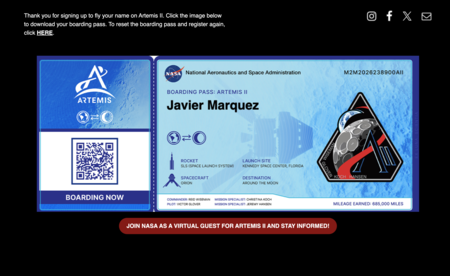That your name travels around the Moon no longer belongs to the realm of fantasy. NASA has once again opened a door so that anyone can register it and watch it travel aboard Artemis IIthe first manned mission of the Artemis program. It will be stored on a memory card inside the Orion spacecraft, which will circle our satellite and return to Earth. But what is relevant is not just the gesture. The agency has been inviting the public to be part of its missions for years. Now, with Artemis, he is renewing that pact between exploration and participation.
NASA does not ask you to register or create an account. Simply enter three basic details on an official website and the system automatically generates a personalized digital pass associated with Artemis II, with the participant’s name. The PIN is the only way to access that pass, and the agency warns that you cannot recover it if it is lost. According to the information available, all the names will be compiled on a digital medium that will travel on the Orion spacecraft during the mission. It has not been confirmed if these names will be consulted or reviewed at some point, but they will be part of the lunar journey in a symbolic way.
A tradition that began with a golden record and is still alive in Artemis
NASA has been looking for ways to leave a human mark on your missions. One of the best-known examples is the Voyager Golden Record, designed in 1977 under the scientific direction of Carl Sagan. It was a metal disc covered in gold with sounds, greetings and images that represented life on Earth. Years later, with Cassini, they moved to a CD-ROM with scanned signatures, and Stardust and OSIRIS-REx used microchips with names sent from all over the world. Artemis II takes another step: a digital memory card, much more similar to the ones we use today in any device.
These initiatives are not understood only as gestures of participation. NASA operates with public funds and needs to justify, year after year, that programs like Artemis make sense beyond scientific interest. Connecting with citizens is a way to keep that support current, especially in missions that take place over decades and require budget continuity. When numerous educational centers, families and fans share their symbolic boarding passes, what they actually do is make visible that space exploration continues to have social, cultural and political relevance.
While Apollo was an unprecedented milestone, it also left a lesson for the future of exploration. After the global impact of the first moon landing, public attention began to fallr, and with it, political and budgetary support. The book “Moonport”, published by NASA, describes how enthusiasm became routine, and how subsequent missions stopped generating interest outside the scientific field. In the early 1970s, Congress reduced funding and thousands of employees were laid off. The program had won the space race, but it lost something just as important: the sustained attention of society.

Artemis advances in a very different context than Apollo, but with a clear lesson: space exploration needs both political continuity and social legitimacy. Today the challenges are no longer only technological, but also strategic. The program is accumulating technical delays and Artemis II is now scheduled for launch between February and April 2026. At the same time, China has accelerated its plans and is developing its own manned program with the aim of sending astronauts to the Moon. Everything seems to indicate that we are facing a new competition, this time more open and prolonged, where public support is once again a decisive element.
As we can see, signing up does not change the course of a mission, but it is part of something broader. It’s not about seeing your name circle the Moon, but about knowing that space exploration continues to involve society and not only to the control centers. Artemis does not only seek to return to our satellite, but rather to build a shared story about why to go, what to go for, and who is invited to take part. It is a way of remembering that this trip also needed an audience, and that perhaps awakens enthusiasm in those who, from a young age, begin to look upward.
Images | NASA | ESA | Screenshot
In WorldOfSoftware | The biggest mystery in science today is dark matter. And a Japanese scientist believes he has detected it
